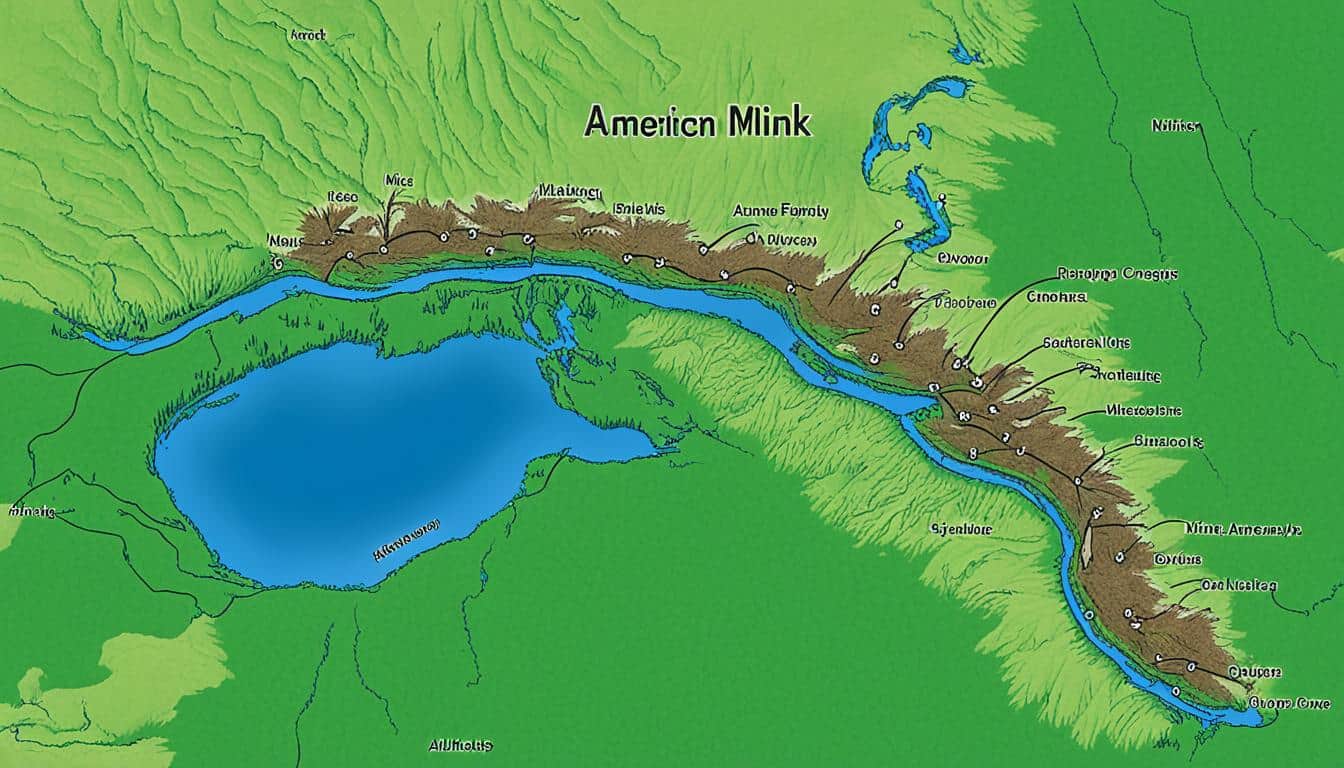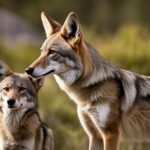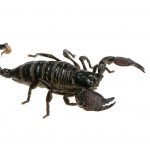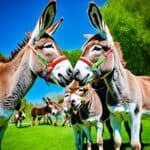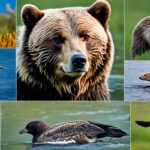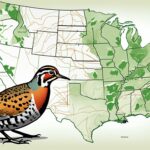Have you ever wondered how the American mink, originally from North America, has spread worldwide? This semiaquatic animal, called Neogale vison, has a wide range. It shows how adaptable it is and its impact on different environments.
The American mink can be found from Alaska’s northern parts to Florida’s south. It lives in various places in North America, missing just Arizona. This special creature plays a critical role in the fur trade. It has also been taken to Europe, Asia, and South America, making its range even wider.
Knowing where the American mink lives helps us see how adaptable it is. It also shows us the big effects of its presence in new places. We’ll look into what makes the mink so successful in spreading and what that means for local species. Let’s find out more about these interesting facts.
Overview of the American Mink’s Habitat Range
The American mink native area is vast and varied, mainly close to water bodies. Rivers, lakes, and streams are key. They offer food and shelter, necessary for the mink’s survival. Their habitats are diverse and strategically located to access these resources.
The American mink has made its home near water bodies. It has adapted well to this life. It has webbed digits, perfect for swimming. This makes it easy for them to hunt and thrive in their watery homes.
Here is a detailed look at the primary components of their habitat:
| Habitat Element | Description |
|---|---|
| Rivers and Streams | Provide flowing water and abundant prey, ideal for hunting. |
| Lakes | Offer still water bodies rich with fish and amphibians. |
| Wetlands | Feature dense vegetation for shelter and nesting. |
Knowing about the semiaquatic mammal habitat helps us understand the mink’s role in the ecosystem. Their life and well-being depend on their surroundings. This shows how important these habitats are for their survival.
Native and Introduced Range of the American Mink
The American mink is native to North America. It lives across much of the United States and Canada. You won’t see them on the Arctic coast or certain islands. Despite this, these animals have made their way to Europe, Asia, and South America thanks to people.
The American mink is very mobile. Because of this, it’s seen as an invasive species in some places. Its presence in these areas can cause problems for local plants and animals. But, whether in their original habitats or these new places, they thrive. This shows their strong ability to adapt.
| Region | Status | Impact |
|---|---|---|
| North America (Native Range) | Native | Balanced role in ecosystem |
| Europe and Asia (Introduced Regions) | Invasive | Disrupts local species |
| South America (Introduced Regions) | Invasive | Negative impact on biodiversity |
American Mink Habitat Preferences
The American mink loves to adapt and has clear home favorites. It finds cozy spots both on land and in water. Each type of home gives the mink special benefits needed to thrive.
Forested Areas
Forests near water, with streams and lakes, are top picks for the American mink. They love these places for their hidden spots and food. The mix of thick plants and water plants is perfect for hunting and shelter. These areas are the best for the mink because they have so much forest by water.
Aquatic Environments
The American mink is at home near water, thanks to its swim-savvy ways. Places like rivers and lakes are great for hunting. Minks can hunt after fish and smaller animals with ease. They dive deep, swim a lot under water, all to catch their prey.
American Mink Location in North America
The American mink is a member of the carnivora order, found all around North America. It’s seen from the northern U.S. to the beautiful landscapes of Canada. Yet, you won’t find them in the far north where it’s too cold and the right homes are missing.
This mink’s ability to live in different places across North America stands out. It can live in forests, wetlands, and next to rivers, showing great adaptability. This makes it a successful part of the carnivora order, able to use many different kinds of environments.
Below is a detailed comparison highlighting key aspects of the American mink’s location in contrasting areas within North America:
| Feature | Northern US | Southern Canada |
|---|---|---|
| Climate | Temperate to cold | Cool to moderate |
| Habitat | Forested areas, waterways | Wetlands, riverbanks |
| Food Sources | Fish, small mammals | Birds, amphibians |
Understanding American Mink Territory
American minks are known for being alone a lot and marking their space. This is especially true for the males. They make sure other males don’t come near by leaving their smell in their areas. These territories are key for finding food, social life, and mating.
Territorial Behavior
Male American minks show a lot of territorial behavior. They leave their scent everywhere to warn others to stay away. Doing this helps keep peace and allows minks to live by themselves, which they prefer.
Home Range
American minks have large areas they call home, sometimes stretching over miles. These places are very important for finding food and survival. Minks work hard to keep these areas safe, marking them to keep out strangers. This is how they make sure they can live and have babies successfully.
Distribution of American Mink Subspecies
The American mink is a fascinating animal known as Neogale vison. It has many subspecies across North America. Each type looks different because it has adapted to living in various places.
Understanding where these minks live helps us see their wide range. The eastern side, the west coast, and even Alaska have their own kinds of minks. This shows how well the Neogale vison fits into its many different home areas.
Now, let’s focus on the different subspecies of the American mink:
| Subspecies | Size | Coloration | Habitat Preference | Geography |
|---|---|---|---|---|
| Neogale vison vison | Medium | Dark Brown | Forests and Streams | Eastern North America |
| Neogale vison energumenos | Large | Reddish Brown | Coastal Areas | Pacific Coast |
| Neogale vison aestuarina | Small | Light Brown | Estuaries | Alaska |
| Neogale vison minkii | Medium | Dark Brown with White Patches | Marshes and Wetlands | Southeastern United States |
This table shows how diverse the Neogale vison is in North America. It highlights the vital role that subspecies play. Learning about them helps us see how each one fits in different environments.
What is the range of the American mink?
The American mink natural range covers vast areas, mostly in North America. This creature loves the water and thrives in different types of places.
Minks are known for their beautiful mink fur. That’s why people have spread them to Europe, Asia, and South America. This has changed the local environments in those places.
In North America, American minks live near water. This includes rivers, lakes, and the coast. It’s perfect for their lifestyle, which heavily involves the water.
| Region | Presence of American Mink | Remarks |
|---|---|---|
| North America | Widely Distributed | Native Habitat |
| Europe | Common in Several Areas | Introduced for Fur Farming |
| Asia | Scattered Populations | Introduced and Naturalized |
| South America | Present | Impacted Local Ecosystems |
Geographic Distribution of the American Mink
The American mink shows us how it can live in many places. People have moved it to new areas. This has let the mink live in places it never could before. It changes the local plants and animals when it moves to a new place.
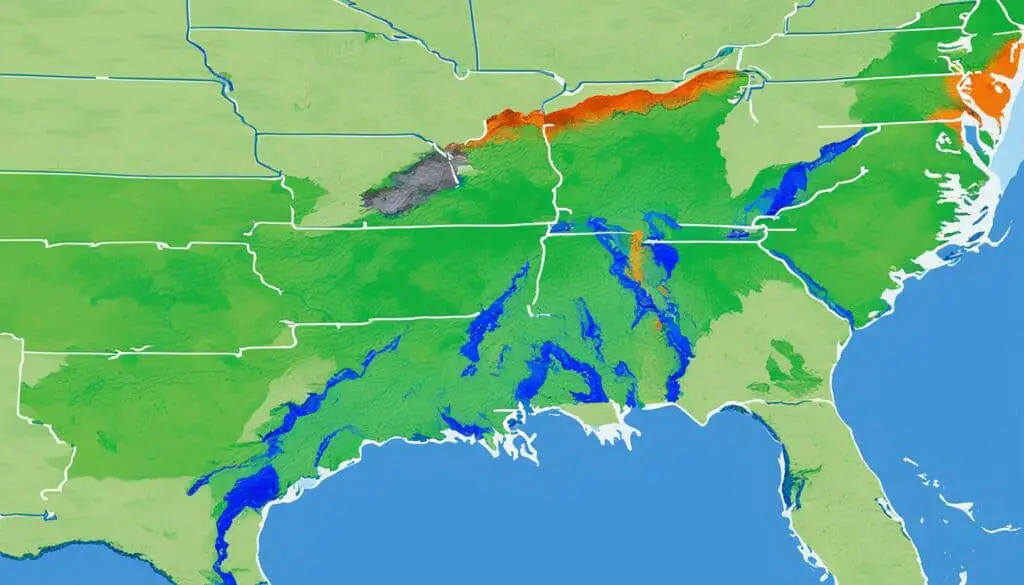
Looking at where the American mink lives now teaches us a lot. Sometimes, the mink can do well in the new places it goes. But, it hasn’t always been good for the animals and plants that were already there.
Now, the American mink lives on many continents. Here’s a table that shows where it is:
| Continent | Native or Introduced |
|---|---|
| North America | Native |
| Europe | Introduced |
| Asia | Introduced |
| South America | Introduced |
This table shows where the American mink is from and where people have moved it. Learning about where the mink is from and where it lives now helps us understand its impact. We see how it affects nature in different parts of the world.
Natural Range of the American Mink
The American mink’s home spans across North America. They love areas with lots of rivers and the sea. This setting gives them everything they need to live well.
Native Areas
The American mink lives all across North America, close to the water. But they don’t choose the Arctic coast or some islands. They can live in dense forests or near the sea.
This shows how good they are at adapting. They help keep the balance in nature by controlling the populations of small animals and fish.
Introduced Regions
These minks have been taken to other places for their fur. Places like Europe, Asia, and South America. But, this has caused problems for the local wildlife.
Now, in these new lands, the American mink causes harm. They fight for resources with local animals, making it hard for them to survive.
So, the American mink has shown it can live in many places. But putting them in new places can damage the local environment. We need to have good plans to handle this problem.
Ecological Importance of the American Mink
The American mink is key in both native and invaded ecosystems. These aspects are crucial to understanding its overall ecological value.
Role in Ecosystem
The American mink plays a big role in native habitats. It preys on fish, small animals, and birds, keeping their numbers in check. By doing so, it helps keep the ecosystem healthy.
Invasive Species Status
However, when the American mink invades new areas, it can cause problems. It competes with local species, affecting biodiversity negatively. Especially impacting ground-nesting birds and small mammals, it can cause ecosystem imbalances.
Efforts to control mink populations in these non-native areas are crucial. This helps protect local species and maintain the ecosystem’s health.
American Mink Conservation Status
The American mink is a species of Least Concern, according to the IUCN. This means it’s not at great risk of big population drops all over its living areas.
But, American minks face dangers such as losing their homes, pollution, and the impact from the fur business. It’s important to deal with these issues early to keep their numbers steady. By doing so, we help them stay strong.
Knowing the American mink’s conservation status guides conservation work. With awareness and action against dangers, we play a role in protecting where the minks live and their health.
The Evolution and Adaptation of the American Mink
The American mink has evolved for a life near water, making it both a hunter and a swimmer. It has kept the same size and shape for millions of years. This shows it has found a successful way of living.
Over time, the mink has grown to have features needed for hunting and swimming. For example, it has a skull that helps it move quickly in the water and fur that keeps it warm. These are very important for living in all kinds of places, like forests and wetlands.
The mink’s ability to adapt can be seen in its webbed feet. These help it swim well and catch its prey easily in the water. Looking at old fossils helps scientists understand how the mink has dealt with changes to its home over the years. By studying how the mink has evolved, we can learn how it became such a successful animal.
FAQ
What is the range of the American mink?
The American mink lives in North America. It spans from Alaska to Florida, but not Arizona. Humans have helped it spread to Europe, Asia, and South America.
What environments does the American mink inhabit?
These minks like places near water, such as rivers and lakes. They need water for food and shelter.
Where is the American mink’s native area?
It’s native to the U.S. and Canada, except the far north. This includes most places but not all offshore islands.
What are the introduced regions for the American mink?
The mink was brought by people to Europe, Asia, and South America. This move has caused problems in those new places.
What are the primary habitat preferences of the American mink?
Minks like living by forests and water. This way, they can hunt with their great swimming skills.
What is the American mink’s location in North America?
They are found across North America, avoiding very cold and unsuitable areas.
How does the American mink establish its territory?
They mark their home with a musky smell. Each mink needs its own space for hunting and eating.
What are the different subspecies of the American mink?
There are different types of American minks, each a bit different. These differences help them live in many places in North America.
How has the geographic distribution of the American mink changed?
Their homes have gone beyond North America to other places. This happened because of people. It has affected the places they now live in.
What are the natural and introduced ranges of the American mink?
They naturally live in North America. Human activity has introduced them to Europe, Asia, and South America, largely for their fur.
What is the ecological importance of the American mink?
In its home, the mink helps keep ecosystems balanced. Yet, in new places, it can harm local plants and animals.
What is the conservation status of the American mink?
The IUCN says it’s not in big danger. But, losing their homes, pollution, and being hunted are big problems for them.
How has the American mink evolved over time?
The mink has changed to love meat and water. They have special feet and fur for hunting in different places.

